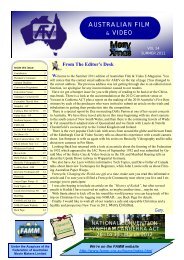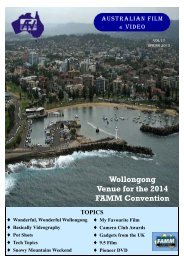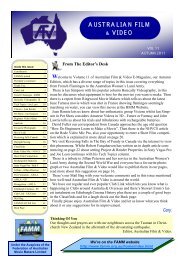Automatic ExposureBy Neal RevilleThere are some subjects that can take up a lot <strong>of</strong> time at meetings. There are some subjects that some memberssteadfastly decline to engage. There are some subjects that are so basic to the art <strong>of</strong> Video making that it is difficultto see how anyone who neglects to learn them can ever hope to progress beyond the level <strong>of</strong> “snap shooter”.There are some subjects that need time for reflection, especially for beginners with no prior exposure to them. Thisis an attempt to address these difficulties. It is intended to keep the content as non-technical as possible while, at thesame time, covering the essentials. Don’t forget, there is nothing to stop you doing some research on your own—oreven asking a question at a meeting. It’s not beyond anyone. If you had come into this business 40 years ago, youwould have had to know all this to get a picture out <strong>of</strong> your camera. Millions managed.H V = E v • t gives us Photometric Exposure (usually in lux-seconds) where the physical quantity <strong>of</strong> visible light energy,weighted by the luminosity function, applied to a surface during a given exposure time (where E v is the image -plane luminance in lux) . . . .No, no, no! That’s not how we hope to do it. Let’s try to keep it simple. So simple, in fact, that we will probablygloss over some aspects that really are important to a complete understanding <strong>of</strong> the subject. So this is a superficiallook at this subject but probably sufficient to illustrate why relying on auto-exposure is not a good idea and some <strong>of</strong>the resulting drawbacks. By the way, do I have a “complete” understanding <strong>of</strong> the subject? Absolutely not!It’s a nice, sunny day. The countryside stretches out before us, just asking to be photographed (or videoed). Fluffyclouds dot the sky and clumps <strong>of</strong> trees promise cool shade. A tourist brochure delight—a photographic nightmare!But, why? Consider the brightness range in this scene. The fluffy clouds reflect a large amount <strong>of</strong> the light fallingupon them. The trees hide most <strong>of</strong> it. It’s safe to say the brightness range is thousands, if not millions, to one. Funnything about our eyes—they have no trouble handling it, but alas, not so our cameras.In a camera, generally speaking, we have one <strong>of</strong> two devices to record a scene—first, a film, second an electronicsensor. A film chemically records the various brightness levels, not doing too well at the darker end where it strugglesto discern one dim item from another, but much better at the brighter end where it records level after level withgood detail. Eventually, its nice, linear response starts to fade, tapering <strong>of</strong>f smoothly into a blank, featureless white.This tapering is relatively unobtrusive and is fairly easy for the photographer to control.This is pretty good. After all, there may not be much to look at in dark shadows and most <strong>of</strong> what we want to see<strong>of</strong>ten happens in the brighter part <strong>of</strong> the world.Page 24 AUSTRALIAN FILM & VIDEO—VOL <strong>20</strong> WINTER <strong>20</strong>13
However, given that film is terminally ill, if not already dead, we should turn our attention to electronic sensors. Howdo they compare with the very satisfactory film? At this stage, let us acknowledge, then forget, that today there existelectronic sensors like that used in the Arriflex Alexa camera that simply outperform everything else—film included.Let us keep our attention on devices available to mere mortals.Accordingly, we find that sensors exhibit just the opposite characteristics to film. (Well, they would have to, wouldn’tthey?!) They dig deeply into the darker layers <strong>of</strong> the scene, uncovering detail there that film would never knowabout. As the brightness grows into the “average “ zones <strong>of</strong> the scene, they follow it faithfully. As we get towards theupper end <strong>of</strong> the brightness scale—we are approaching those “fluffy clouds” now—we suddenly strike one <strong>of</strong> thosedown-sides <strong>of</strong> digital recording. There is no tapering-<strong>of</strong>f. When the numbers reach their limit, for that’s what we arerecording, they stop. That’s it! Kaput! The effect is, we go from a perfectly nice, quite bright scene to a blank, glaring,washed-out patch in an instant. There is no “fix it in post”. In that ugly, blank white area there is nothing. Nothingto recover or improve.OK, where does that leave us? We had film which was poor at the dark end <strong>of</strong> the scale and forgiving at the brightend, and have electronic sensors which are excellent in darker areas and absolutely unforgiving at the top. Keep thisin the back <strong>of</strong> your mind while we consider a couple <strong>of</strong> other factors.Film had a couple <strong>of</strong> other characteristics. One was “speed”. Simply, the chemistry could be manipulated in manufactureto make the film more or less sensitive to light. As might be imagined, “slow” films were good in bright conditionsand “fast” films better in dim. The speed was rated in a myriad <strong>of</strong> systems over the years, the sensible GermanDIN system (logarithmic, where each increase <strong>of</strong> 3 degrees indicated a doubling <strong>of</strong> speed) and the Americannumerical system, called ASA, where each doubling <strong>of</strong> speed required doubling <strong>of</strong> the index number. As late as<strong>20</strong>06, the ISO (International Standards Organisation) stepped in having established the ISO rating, adopting theAmerican system because it was “simpler”(!).Slow films, like early Kodachrome, had a rating <strong>of</strong> ISO 10 while fast ones, like Tri X (black & white), were aroundISO 400. Currently, the fastest motion-picture films in general use are around ISO 500. Digital cameras are a differentstory. “Speeds”, or sensitivity, are set by manipulating the sensitivity <strong>of</strong> the sensor and/or the gain <strong>of</strong> the videoamplifiers. The higher the gain, <strong>of</strong> course, the more electrical “noise” is introduced into the picture. Notwithstandingthis, reflex cameras are capable <strong>of</strong> good pictures up to around ISO 3<strong>20</strong>0 and the Panasonic AF102 to 1600 ISO. Thisis fantastic! At 800 ISO it is feasible to take movies at night with available street lighting, or light a subject with amatch or single candle.But, back to those clouds before they blow away! From our digression(s), it should be apparent that our camera isjust not able to handle the brightness range <strong>of</strong> the scene. No problem, simply set the exposure to accommodate thebrightness <strong>of</strong> the clouds, if we want them in the picture. This may mean sacrificing some detail in the shadows butthat’s your creative decision. But, here comes the fly in the ointment.Mid (18%) greyIn your consumer camera lives a reflected light meter. Its job is to measure the scene brightnessand set the exposure. This meter is calibrated with respect to a mid-grey, <strong>of</strong> 18% reflectance andit sets your exposure accordingly. Now, there will almost certainly be things in the scene we aredescribing that reflect around the same as our 18% grey, and they will be correctly exposed butthings that are brighter than this grey, to a degree that exceeds the brightness range <strong>of</strong> our system,will clip. This includes our clouds and, instead <strong>of</strong> rendering as bright, detailed objects, asthey are, they reproduce as a bare, burned-out patch with no detail, ugly and featureless. Thisblank, white, burned-out patch may well include most, or all <strong>of</strong> the sky as well.What should we have done? We should have set the exposure higher in the brightness range in our picture and allowedthe lower brightness objects to fall where they will. (In fact, we should have tried to reduce the brightnessrange <strong>of</strong> the picture to better suit the available range <strong>of</strong> the camera, but that’s another story.)The rule <strong>of</strong> thumb is: “Protect your highlights.”In fact, it’s worse than that. Had we tried to shift the auto exposure range <strong>of</strong> the camera towards the bright end andavoiding clipping <strong>of</strong> the whites, we risk converting the blacks in our picture to a grey and perhaps making them“milky”. Those who try to be serious about their videos do not ask for all these manual exposure controls lightly. It’snot about trying to look “pr<strong>of</strong>essional”. It’s because all <strong>of</strong> these controls are necessary if the job is to be done properly.AUSTRALIAN FILM & VIDEO—VOL <strong>20</strong> WINTER <strong>20</strong>13Page 25










